CME203 Report: Construction Process of Sutton Forest Building Upgrade
VerifiedAdded on 2022/08/24
|34
|6024
|17
Report
AI Summary
This report details the construction procedures for the upgrade of the Sutton Forest Meat Building in Sydney, focusing on the development of a 22-story hotel tower. It covers crucial aspects of the construction process, including demolition of internal elements, external wall support, and excavation techniques for the substructure. The report elaborates on planning, including background information and strategic decisions like the use of prefabricated materials. Various demolition methods are analyzed, with a focus on the selective demolition approach. The report also discusses substructure construction, including excavation, protection and underpinning of existing buildings, and the construction of basement footings, walls, and the foundation slab. Safety working methods are also addressed. The project involves integrating architectural designs and optimizing resources to minimize costs and ensure timely project completion. The report highlights the importance of proper planning, resource management, and the use of qualified professionals throughout the construction process.
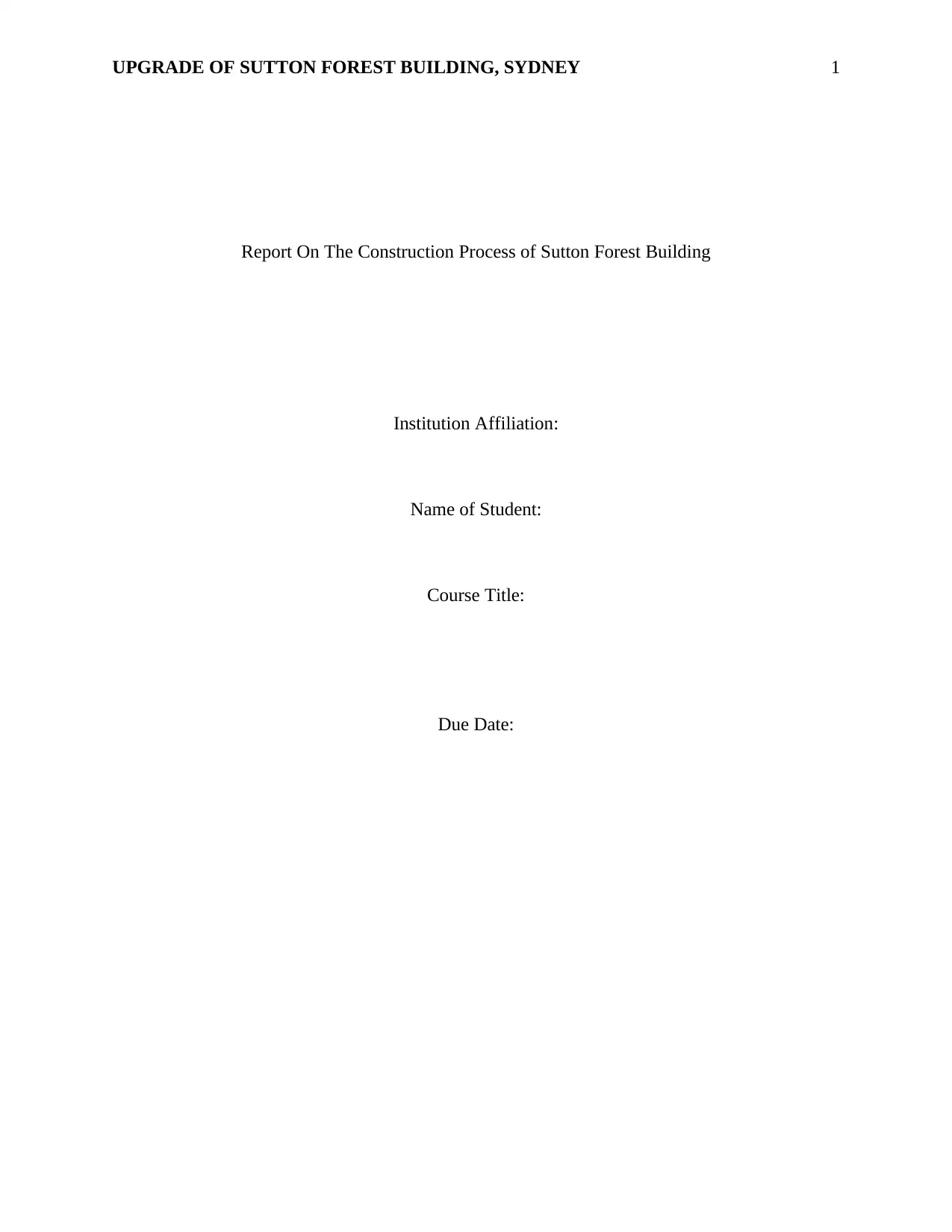
UPGRADE OF SUTTON FOREST BUILDING, SYDNEY 1
Report On The Construction Process of Sutton Forest Building
Institution Affiliation:
Name of Student:
Course Title:
Due Date:
Report On The Construction Process of Sutton Forest Building
Institution Affiliation:
Name of Student:
Course Title:
Due Date:
Paraphrase This Document
Need a fresh take? Get an instant paraphrase of this document with our AI Paraphraser
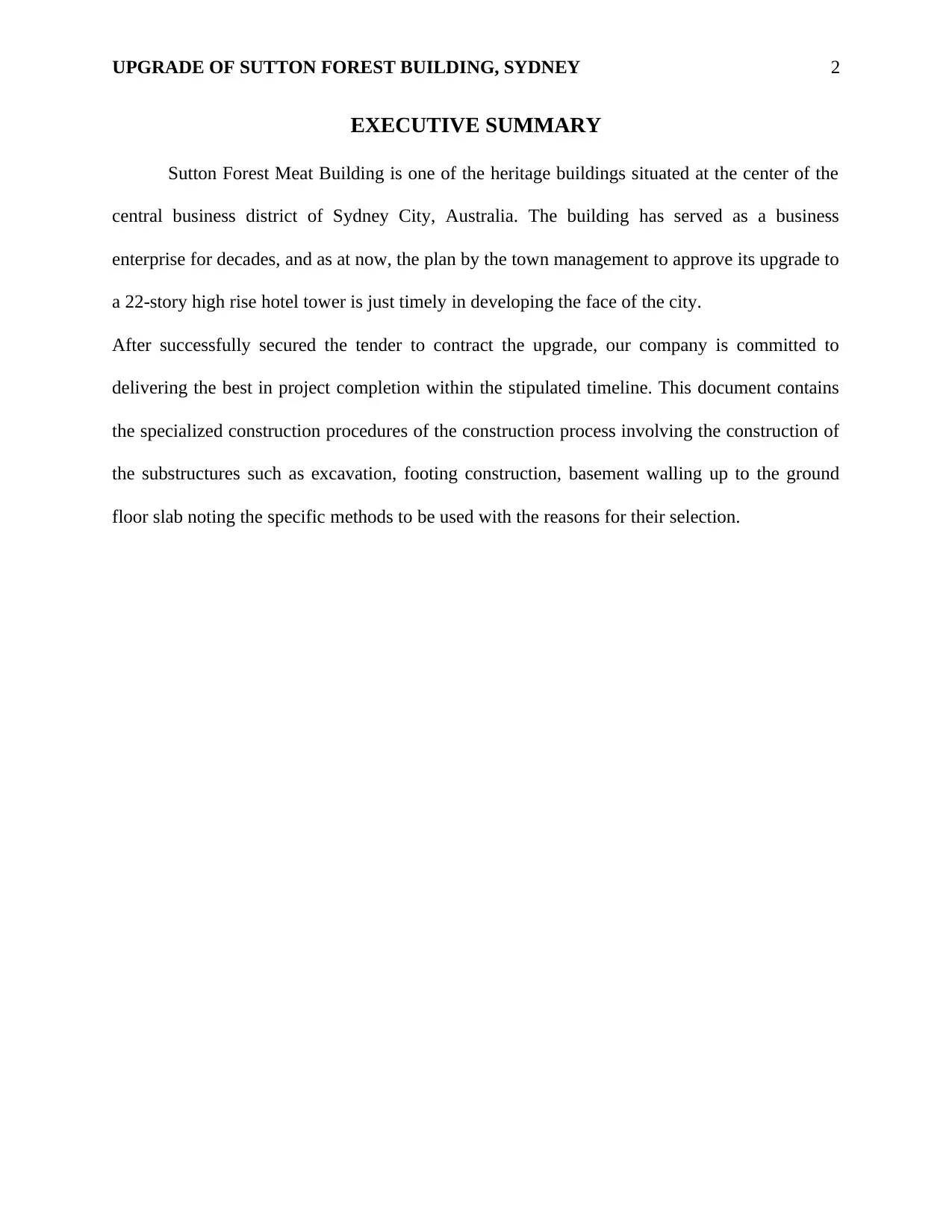
UPGRADE OF SUTTON FOREST BUILDING, SYDNEY 2
EXECUTIVE SUMMARY
Sutton Forest Meat Building is one of the heritage buildings situated at the center of the
central business district of Sydney City, Australia. The building has served as a business
enterprise for decades, and as at now, the plan by the town management to approve its upgrade to
a 22-story high rise hotel tower is just timely in developing the face of the city.
After successfully secured the tender to contract the upgrade, our company is committed to
delivering the best in project completion within the stipulated timeline. This document contains
the specialized construction procedures of the construction process involving the construction of
the substructures such as excavation, footing construction, basement walling up to the ground
floor slab noting the specific methods to be used with the reasons for their selection.
EXECUTIVE SUMMARY
Sutton Forest Meat Building is one of the heritage buildings situated at the center of the
central business district of Sydney City, Australia. The building has served as a business
enterprise for decades, and as at now, the plan by the town management to approve its upgrade to
a 22-story high rise hotel tower is just timely in developing the face of the city.
After successfully secured the tender to contract the upgrade, our company is committed to
delivering the best in project completion within the stipulated timeline. This document contains
the specialized construction procedures of the construction process involving the construction of
the substructures such as excavation, footing construction, basement walling up to the ground
floor slab noting the specific methods to be used with the reasons for their selection.
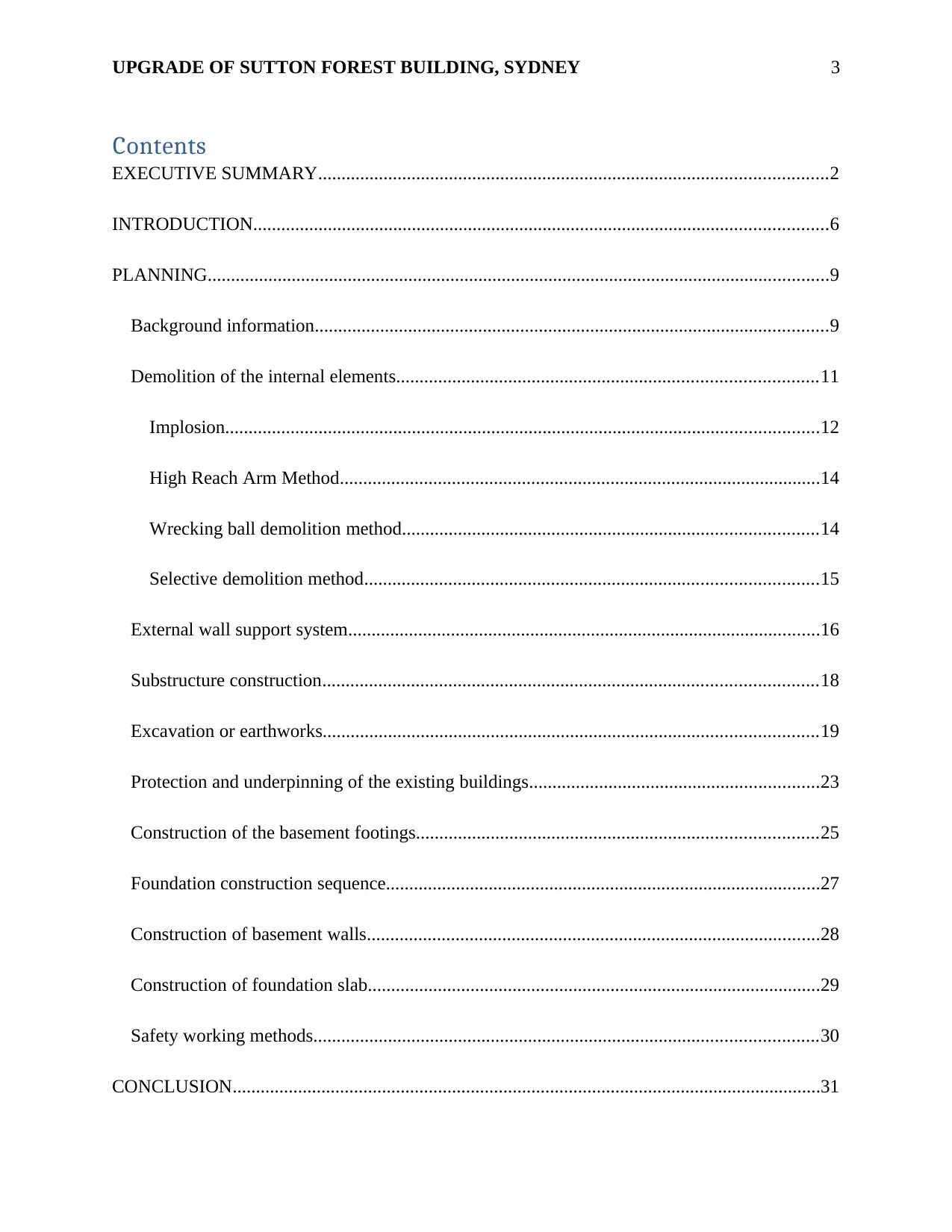
UPGRADE OF SUTTON FOREST BUILDING, SYDNEY 3
Contents
EXECUTIVE SUMMARY.............................................................................................................2
INTRODUCTION...........................................................................................................................6
PLANNING.....................................................................................................................................9
Background information..............................................................................................................9
Demolition of the internal elements..........................................................................................11
Implosion...............................................................................................................................12
High Reach Arm Method.......................................................................................................14
Wrecking ball demolition method.........................................................................................14
Selective demolition method.................................................................................................15
External wall support system.....................................................................................................16
Substructure construction..........................................................................................................18
Excavation or earthworks..........................................................................................................19
Protection and underpinning of the existing buildings..............................................................23
Construction of the basement footings......................................................................................25
Foundation construction sequence.............................................................................................27
Construction of basement walls.................................................................................................28
Construction of foundation slab.................................................................................................29
Safety working methods............................................................................................................30
CONCLUSION..............................................................................................................................31
Contents
EXECUTIVE SUMMARY.............................................................................................................2
INTRODUCTION...........................................................................................................................6
PLANNING.....................................................................................................................................9
Background information..............................................................................................................9
Demolition of the internal elements..........................................................................................11
Implosion...............................................................................................................................12
High Reach Arm Method.......................................................................................................14
Wrecking ball demolition method.........................................................................................14
Selective demolition method.................................................................................................15
External wall support system.....................................................................................................16
Substructure construction..........................................................................................................18
Excavation or earthworks..........................................................................................................19
Protection and underpinning of the existing buildings..............................................................23
Construction of the basement footings......................................................................................25
Foundation construction sequence.............................................................................................27
Construction of basement walls.................................................................................................28
Construction of foundation slab.................................................................................................29
Safety working methods............................................................................................................30
CONCLUSION..............................................................................................................................31
⊘ This is a preview!⊘
Do you want full access?
Subscribe today to unlock all pages.

Trusted by 1+ million students worldwide
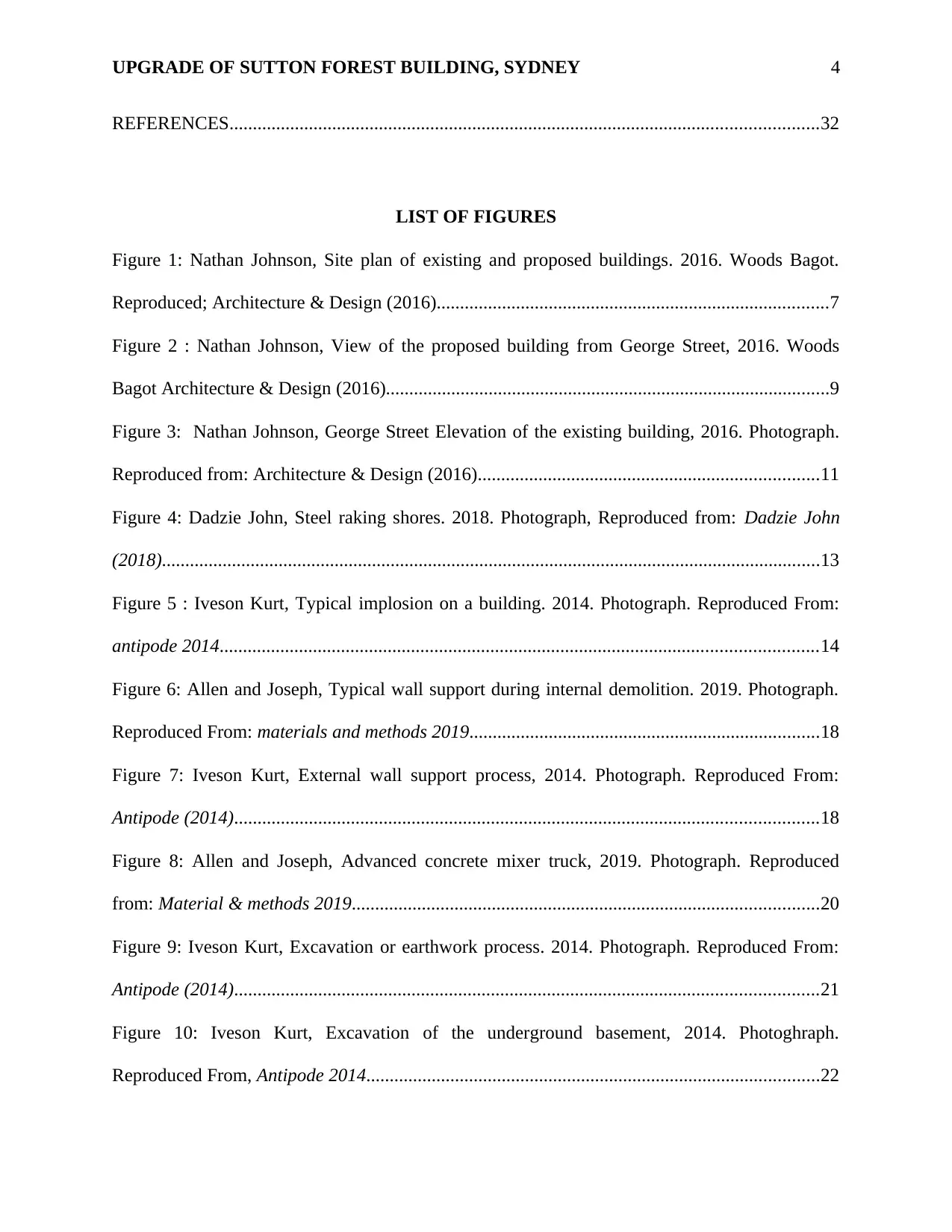
UPGRADE OF SUTTON FOREST BUILDING, SYDNEY 4
REFERENCES..............................................................................................................................32
LIST OF FIGURES
Figure 1: Nathan Johnson, Site plan of existing and proposed buildings. 2016. Woods Bagot.
Reproduced; Architecture & Design (2016)....................................................................................7
Figure 2 : Nathan Johnson, View of the proposed building from George Street, 2016. Woods
Bagot Architecture & Design (2016)...............................................................................................9
Figure 3: Nathan Johnson, George Street Elevation of the existing building, 2016. Photograph.
Reproduced from: Architecture & Design (2016).........................................................................11
Figure 4: Dadzie John, Steel raking shores. 2018. Photograph, Reproduced from: Dadzie John
(2018).............................................................................................................................................13
Figure 5 : Iveson Kurt, Typical implosion on a building. 2014. Photograph. Reproduced From:
antipode 2014................................................................................................................................14
Figure 6: Allen and Joseph, Typical wall support during internal demolition. 2019. Photograph.
Reproduced From: materials and methods 2019...........................................................................18
Figure 7: Iveson Kurt, External wall support process, 2014. Photograph. Reproduced From:
Antipode (2014).............................................................................................................................18
Figure 8: Allen and Joseph, Advanced concrete mixer truck, 2019. Photograph. Reproduced
from: Material & methods 2019....................................................................................................20
Figure 9: Iveson Kurt, Excavation or earthwork process. 2014. Photograph. Reproduced From:
Antipode (2014).............................................................................................................................21
Figure 10: Iveson Kurt, Excavation of the underground basement, 2014. Photoghraph.
Reproduced From, Antipode 2014.................................................................................................22
REFERENCES..............................................................................................................................32
LIST OF FIGURES
Figure 1: Nathan Johnson, Site plan of existing and proposed buildings. 2016. Woods Bagot.
Reproduced; Architecture & Design (2016)....................................................................................7
Figure 2 : Nathan Johnson, View of the proposed building from George Street, 2016. Woods
Bagot Architecture & Design (2016)...............................................................................................9
Figure 3: Nathan Johnson, George Street Elevation of the existing building, 2016. Photograph.
Reproduced from: Architecture & Design (2016).........................................................................11
Figure 4: Dadzie John, Steel raking shores. 2018. Photograph, Reproduced from: Dadzie John
(2018).............................................................................................................................................13
Figure 5 : Iveson Kurt, Typical implosion on a building. 2014. Photograph. Reproduced From:
antipode 2014................................................................................................................................14
Figure 6: Allen and Joseph, Typical wall support during internal demolition. 2019. Photograph.
Reproduced From: materials and methods 2019...........................................................................18
Figure 7: Iveson Kurt, External wall support process, 2014. Photograph. Reproduced From:
Antipode (2014).............................................................................................................................18
Figure 8: Allen and Joseph, Advanced concrete mixer truck, 2019. Photograph. Reproduced
from: Material & methods 2019....................................................................................................20
Figure 9: Iveson Kurt, Excavation or earthwork process. 2014. Photograph. Reproduced From:
Antipode (2014).............................................................................................................................21
Figure 10: Iveson Kurt, Excavation of the underground basement, 2014. Photoghraph.
Reproduced From, Antipode 2014.................................................................................................22
Paraphrase This Document
Need a fresh take? Get an instant paraphrase of this document with our AI Paraphraser
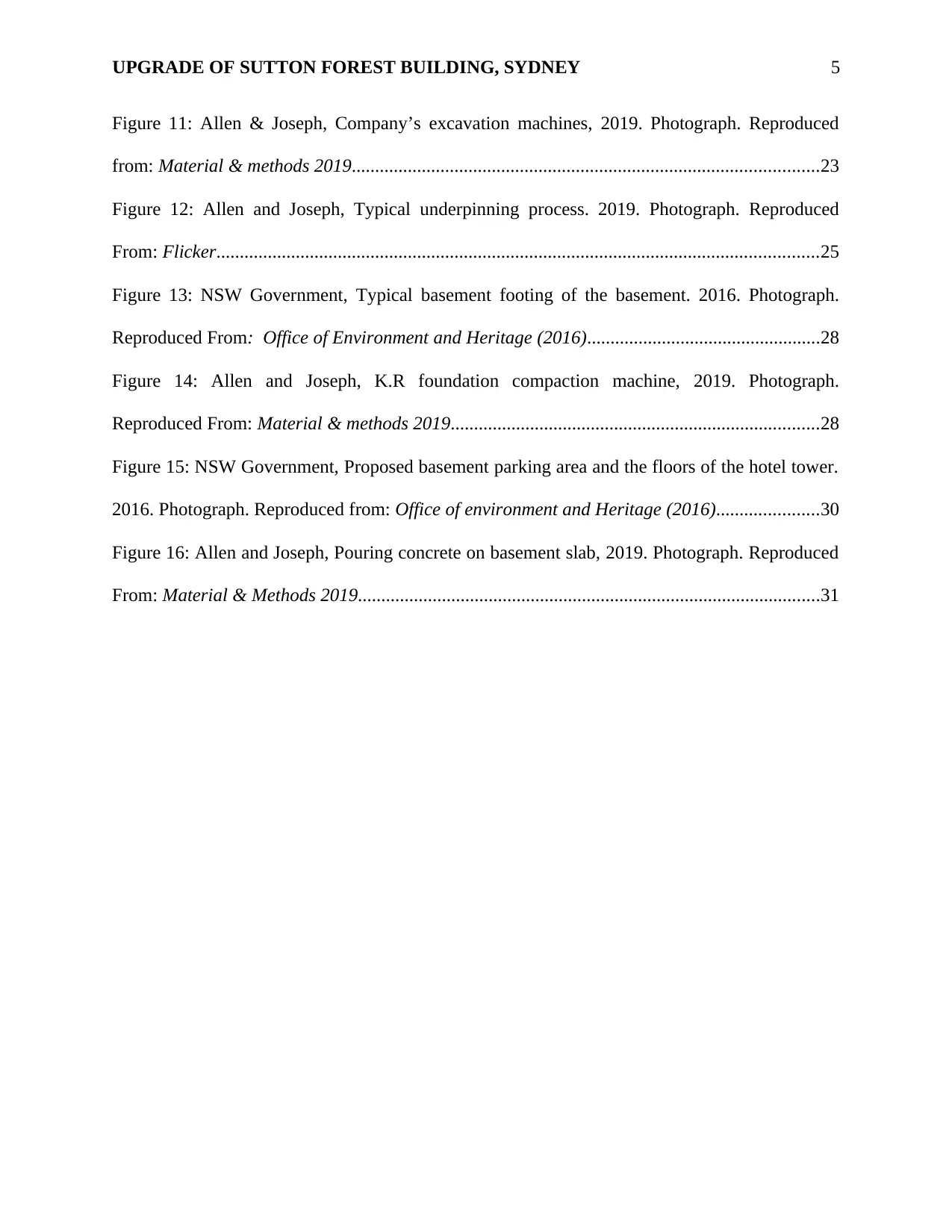
UPGRADE OF SUTTON FOREST BUILDING, SYDNEY 5
Figure 11: Allen & Joseph, Company’s excavation machines, 2019. Photograph. Reproduced
from: Material & methods 2019....................................................................................................23
Figure 12: Allen and Joseph, Typical underpinning process. 2019. Photograph. Reproduced
From: Flicker.................................................................................................................................25
Figure 13: NSW Government, Typical basement footing of the basement. 2016. Photograph.
Reproduced From: Office of Environment and Heritage (2016)..................................................28
Figure 14: Allen and Joseph, K.R foundation compaction machine, 2019. Photograph.
Reproduced From: Material & methods 2019...............................................................................28
Figure 15: NSW Government, Proposed basement parking area and the floors of the hotel tower.
2016. Photograph. Reproduced from: Office of environment and Heritage (2016)......................30
Figure 16: Allen and Joseph, Pouring concrete on basement slab, 2019. Photograph. Reproduced
From: Material & Methods 2019...................................................................................................31
Figure 11: Allen & Joseph, Company’s excavation machines, 2019. Photograph. Reproduced
from: Material & methods 2019....................................................................................................23
Figure 12: Allen and Joseph, Typical underpinning process. 2019. Photograph. Reproduced
From: Flicker.................................................................................................................................25
Figure 13: NSW Government, Typical basement footing of the basement. 2016. Photograph.
Reproduced From: Office of Environment and Heritage (2016)..................................................28
Figure 14: Allen and Joseph, K.R foundation compaction machine, 2019. Photograph.
Reproduced From: Material & methods 2019...............................................................................28
Figure 15: NSW Government, Proposed basement parking area and the floors of the hotel tower.
2016. Photograph. Reproduced from: Office of environment and Heritage (2016)......................30
Figure 16: Allen and Joseph, Pouring concrete on basement slab, 2019. Photograph. Reproduced
From: Material & Methods 2019...................................................................................................31

UPGRADE OF SUTTON FOREST BUILDING, SYDNEY 6
INTRODUCTION
In the construction process, space is crucial, and space for construction expansion is quite
limited in most of these developed cities such as Sydney hence any structural advancement in
cities calls for the upgrade of the existing structures and buildings to high rise buildings to
conform to the latest trends and designs in architectural and construction space (Horta, Isabel &
Camanho, 2014). This report is to outline and elaborate on the construction procedures that our
company will apply in the whole process of upgrading the Sutton Forest Meat Building in
Sydney central business district to have a postmodern hotel tower on top of the ancient two-story
Sutton forest meet building.
Figure 1: Nathan Johnson, Site plan of existing and proposed buildings. 2016. Woods Bagot.
Reproduced; Architecture & Design (2016)
INTRODUCTION
In the construction process, space is crucial, and space for construction expansion is quite
limited in most of these developed cities such as Sydney hence any structural advancement in
cities calls for the upgrade of the existing structures and buildings to high rise buildings to
conform to the latest trends and designs in architectural and construction space (Horta, Isabel &
Camanho, 2014). This report is to outline and elaborate on the construction procedures that our
company will apply in the whole process of upgrading the Sutton Forest Meat Building in
Sydney central business district to have a postmodern hotel tower on top of the ancient two-story
Sutton forest meet building.
Figure 1: Nathan Johnson, Site plan of existing and proposed buildings. 2016. Woods Bagot.
Reproduced; Architecture & Design (2016)
⊘ This is a preview!⊘
Do you want full access?
Subscribe today to unlock all pages.

Trusted by 1+ million students worldwide

UPGRADE OF SUTTON FOREST BUILDING, SYDNEY 7
After successfully making applications and complying to the requirements by the Sydney City
Construction authorities, the first stage is to develop the preliminary construction techniques that
involve the method of demolishing the internal elements of existing Sutton Forest meat building,
methods of providing support to the external walls, excavation techniques to attain the proposed
basement required in the proposed high rise building. All these activities have to be carried out
with keen consideration of the existing adjusted buildings to avoid the underpinning of these
buildings (Ling et al. 2015).
This report also gives elaborate details on how proper planning of the available resources
and facilities can be optimized inappropriate measures to achieve the objective of this project,
which is to construct a high rise structure on top of the defunct Sutton Forest Building.
After successfully making applications and complying to the requirements by the Sydney City
Construction authorities, the first stage is to develop the preliminary construction techniques that
involve the method of demolishing the internal elements of existing Sutton Forest meat building,
methods of providing support to the external walls, excavation techniques to attain the proposed
basement required in the proposed high rise building. All these activities have to be carried out
with keen consideration of the existing adjusted buildings to avoid the underpinning of these
buildings (Ling et al. 2015).
This report also gives elaborate details on how proper planning of the available resources
and facilities can be optimized inappropriate measures to achieve the objective of this project,
which is to construct a high rise structure on top of the defunct Sutton Forest Building.
Paraphrase This Document
Need a fresh take? Get an instant paraphrase of this document with our AI Paraphraser
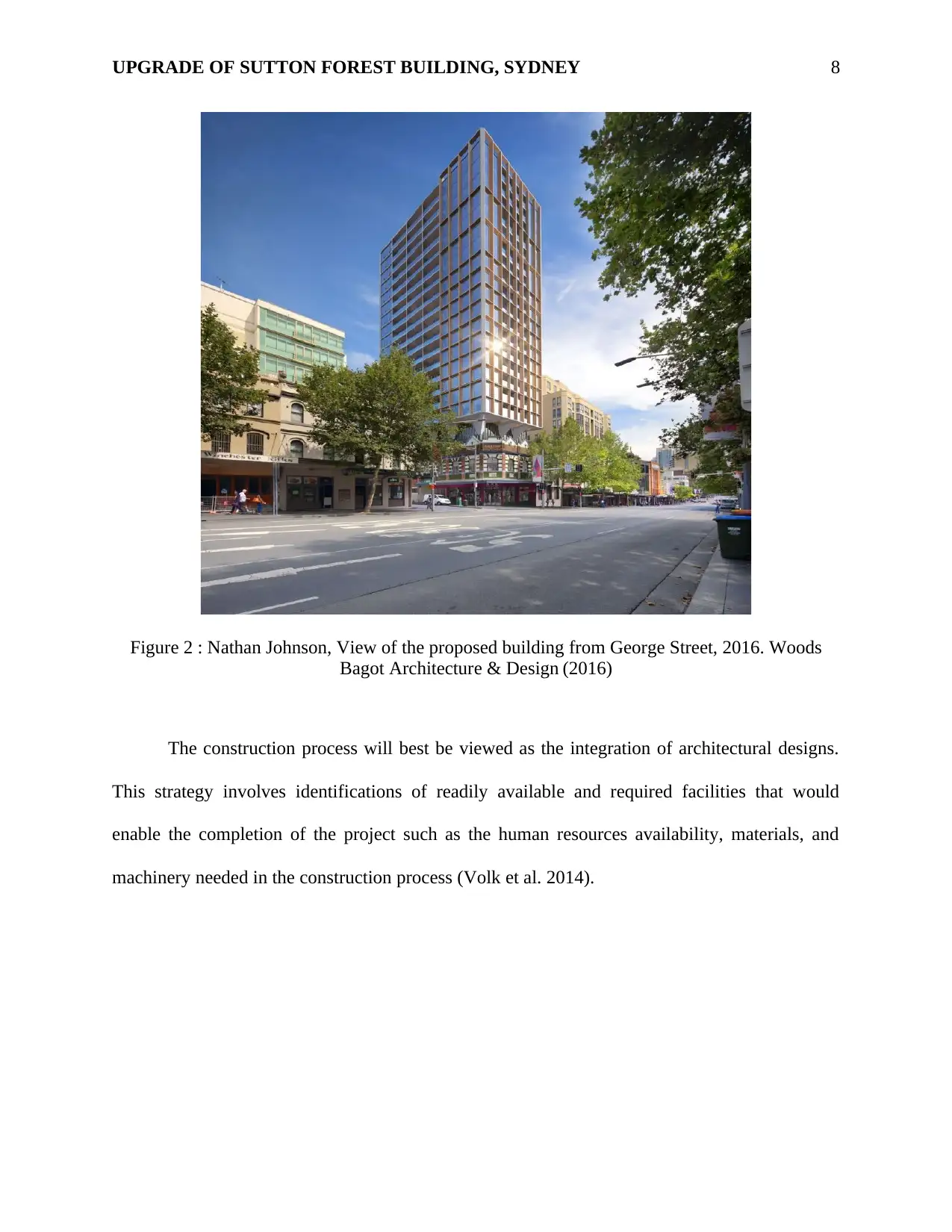
UPGRADE OF SUTTON FOREST BUILDING, SYDNEY 8
Figure 2 : Nathan Johnson, View of the proposed building from George Street, 2016. Woods
Bagot Architecture & Design (2016)
The construction process will best be viewed as the integration of architectural designs.
This strategy involves identifications of readily available and required facilities that would
enable the completion of the project such as the human resources availability, materials, and
machinery needed in the construction process (Volk et al. 2014).
Figure 2 : Nathan Johnson, View of the proposed building from George Street, 2016. Woods
Bagot Architecture & Design (2016)
The construction process will best be viewed as the integration of architectural designs.
This strategy involves identifications of readily available and required facilities that would
enable the completion of the project such as the human resources availability, materials, and
machinery needed in the construction process (Volk et al. 2014).
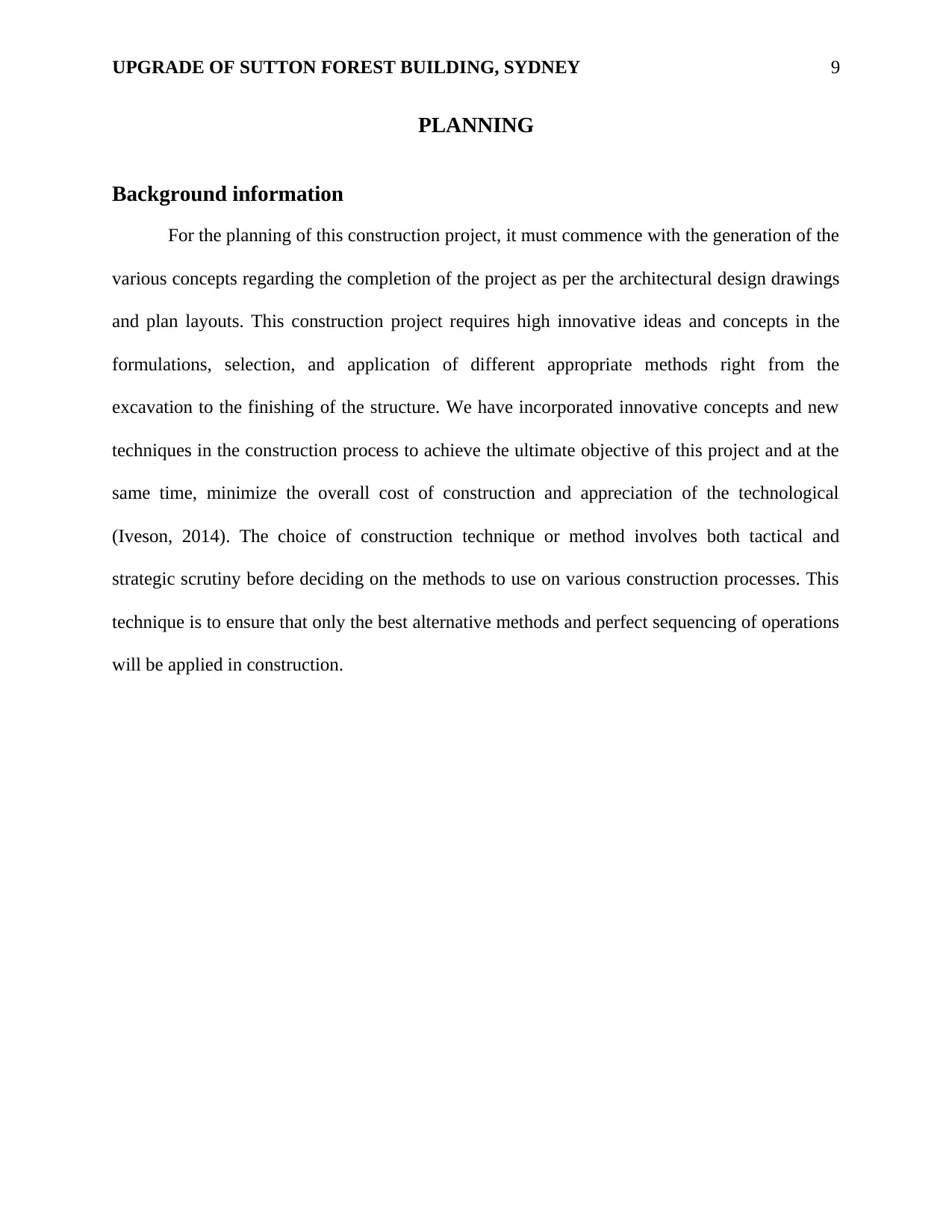
UPGRADE OF SUTTON FOREST BUILDING, SYDNEY 9
PLANNING
Background information
For the planning of this construction project, it must commence with the generation of the
various concepts regarding the completion of the project as per the architectural design drawings
and plan layouts. This construction project requires high innovative ideas and concepts in the
formulations, selection, and application of different appropriate methods right from the
excavation to the finishing of the structure. We have incorporated innovative concepts and new
techniques in the construction process to achieve the ultimate objective of this project and at the
same time, minimize the overall cost of construction and appreciation of the technological
(Iveson, 2014). The choice of construction technique or method involves both tactical and
strategic scrutiny before deciding on the methods to use on various construction processes. This
technique is to ensure that only the best alternative methods and perfect sequencing of operations
will be applied in construction.
PLANNING
Background information
For the planning of this construction project, it must commence with the generation of the
various concepts regarding the completion of the project as per the architectural design drawings
and plan layouts. This construction project requires high innovative ideas and concepts in the
formulations, selection, and application of different appropriate methods right from the
excavation to the finishing of the structure. We have incorporated innovative concepts and new
techniques in the construction process to achieve the ultimate objective of this project and at the
same time, minimize the overall cost of construction and appreciation of the technological
(Iveson, 2014). The choice of construction technique or method involves both tactical and
strategic scrutiny before deciding on the methods to use on various construction processes. This
technique is to ensure that only the best alternative methods and perfect sequencing of operations
will be applied in construction.
⊘ This is a preview!⊘
Do you want full access?
Subscribe today to unlock all pages.

Trusted by 1+ million students worldwide

UPGRADE OF SUTTON FOREST BUILDING, SYDNEY 10
Figure 3: Nathan Johnson, George Street Elevation of the existing building, 2016. Photograph.
Reproduced from: Architecture & Design (2016)
For instance, plans for partitioning of internal rooms will be done with prefabricated
construction materials and this is a strategic construction decision since they will be made off-
site and only transported to the construction site as ready to use, this will help in space
conservation and non-interference to daily operations of the nearby businesses (Horta, Isabel &
Camanho. 2014). Other strategical planning will involve the installation of mechanical
equipment in place before the start of the process together with tactical plans on how to
accomplish given tasks within the scheduled time frame.
To avoid confusion and misinterpretation of the different roles of various professional
personnel within the construction project management, these confusions are mainly attributed to
the range of issues revolving around lack of proper information working dynamics on the field
Figure 3: Nathan Johnson, George Street Elevation of the existing building, 2016. Photograph.
Reproduced from: Architecture & Design (2016)
For instance, plans for partitioning of internal rooms will be done with prefabricated
construction materials and this is a strategic construction decision since they will be made off-
site and only transported to the construction site as ready to use, this will help in space
conservation and non-interference to daily operations of the nearby businesses (Horta, Isabel &
Camanho. 2014). Other strategical planning will involve the installation of mechanical
equipment in place before the start of the process together with tactical plans on how to
accomplish given tasks within the scheduled time frame.
To avoid confusion and misinterpretation of the different roles of various professional
personnel within the construction project management, these confusions are mainly attributed to
the range of issues revolving around lack of proper information working dynamics on the field
Paraphrase This Document
Need a fresh take? Get an instant paraphrase of this document with our AI Paraphraser

UPGRADE OF SUTTON FOREST BUILDING, SYDNEY 11
professionals and to prevent these confusions throughout the construction process only qualified,
and appropriate professionals will be engaged in the construction processes (Gowans et al,
2015).
Demolition of the internal elements
Typically there various modes and methods of demolition in construction field, the
application of any specific methods depends on variety of factors such as the size of the
structure, nature of the building geographical location, space, purpose of demolition, cost of
demolition, availability of demolition tools and types of machinery, etc. for this project, the
purpose is to demolish only the internal elements of the structure and leaving the external brick
to envelop intact to form the basis of construction of other floors, talking of the area of Sutton
Forest building, it’s situated at the Conner of a busy street, and within the central business
district thus any method to be applied in demolishing the internal structures should be safe such
that it does not interfere with town’s daily operations and not to affect in any way the strength of
the external envelope structures. (Franklin, Young & Powell, 2014)
Just but to mention, some of the demolition methods are implosion, high reach arm,
selective demolition, wrecking ball, and manual demolition.
professionals and to prevent these confusions throughout the construction process only qualified,
and appropriate professionals will be engaged in the construction processes (Gowans et al,
2015).
Demolition of the internal elements
Typically there various modes and methods of demolition in construction field, the
application of any specific methods depends on variety of factors such as the size of the
structure, nature of the building geographical location, space, purpose of demolition, cost of
demolition, availability of demolition tools and types of machinery, etc. for this project, the
purpose is to demolish only the internal elements of the structure and leaving the external brick
to envelop intact to form the basis of construction of other floors, talking of the area of Sutton
Forest building, it’s situated at the Conner of a busy street, and within the central business
district thus any method to be applied in demolishing the internal structures should be safe such
that it does not interfere with town’s daily operations and not to affect in any way the strength of
the external envelope structures. (Franklin, Young & Powell, 2014)
Just but to mention, some of the demolition methods are implosion, high reach arm,
selective demolition, wrecking ball, and manual demolition.
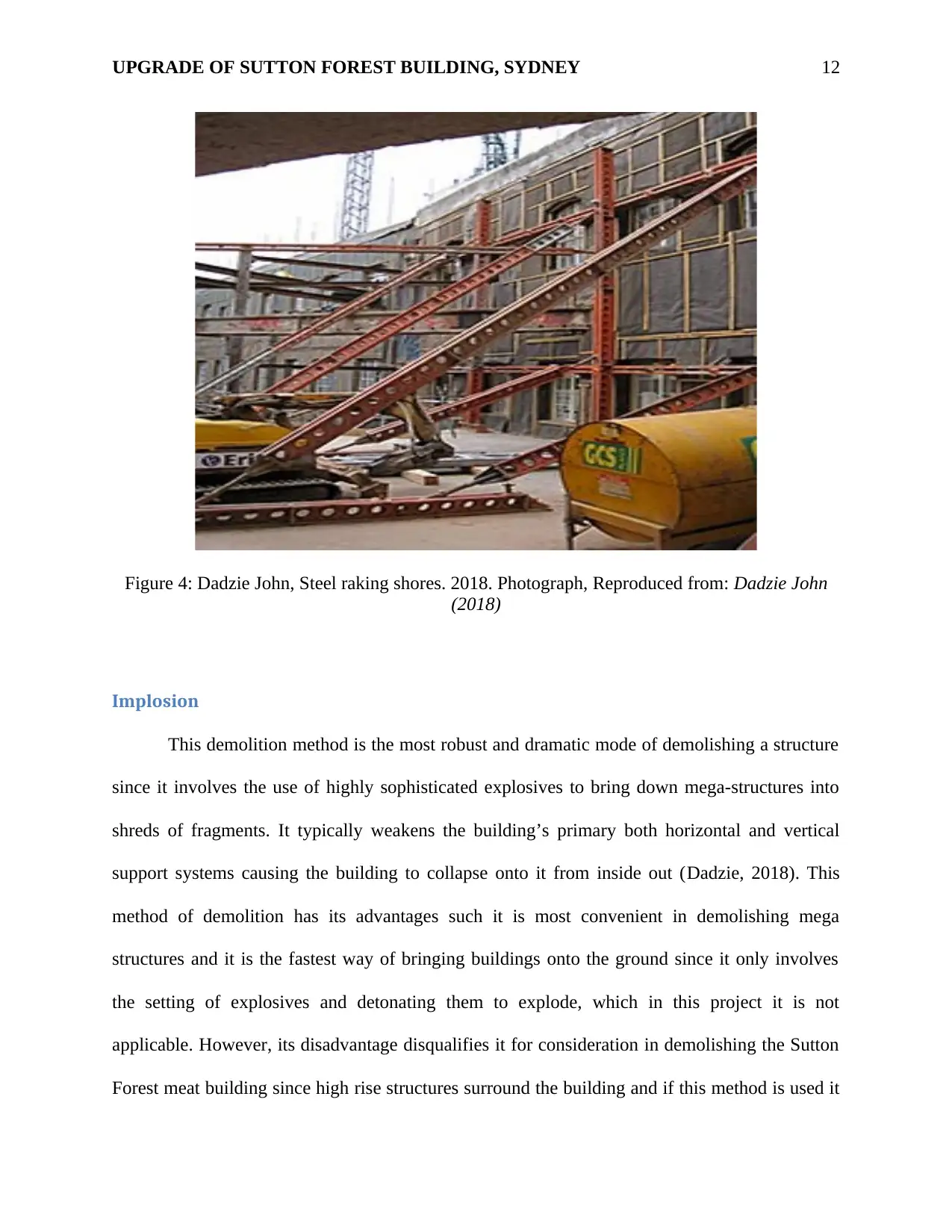
UPGRADE OF SUTTON FOREST BUILDING, SYDNEY 12
Figure 4: Dadzie John, Steel raking shores. 2018. Photograph, Reproduced from: Dadzie John
(2018)
Implosion
This demolition method is the most robust and dramatic mode of demolishing a structure
since it involves the use of highly sophisticated explosives to bring down mega-structures into
shreds of fragments. It typically weakens the building’s primary both horizontal and vertical
support systems causing the building to collapse onto it from inside out (Dadzie, 2018). This
method of demolition has its advantages such it is most convenient in demolishing mega
structures and it is the fastest way of bringing buildings onto the ground since it only involves
the setting of explosives and detonating them to explode, which in this project it is not
applicable. However, its disadvantage disqualifies it for consideration in demolishing the Sutton
Forest meat building since high rise structures surround the building and if this method is used it
Figure 4: Dadzie John, Steel raking shores. 2018. Photograph, Reproduced from: Dadzie John
(2018)
Implosion
This demolition method is the most robust and dramatic mode of demolishing a structure
since it involves the use of highly sophisticated explosives to bring down mega-structures into
shreds of fragments. It typically weakens the building’s primary both horizontal and vertical
support systems causing the building to collapse onto it from inside out (Dadzie, 2018). This
method of demolition has its advantages such it is most convenient in demolishing mega
structures and it is the fastest way of bringing buildings onto the ground since it only involves
the setting of explosives and detonating them to explode, which in this project it is not
applicable. However, its disadvantage disqualifies it for consideration in demolishing the Sutton
Forest meat building since high rise structures surround the building and if this method is used it
⊘ This is a preview!⊘
Do you want full access?
Subscribe today to unlock all pages.

Trusted by 1+ million students worldwide
1 out of 34